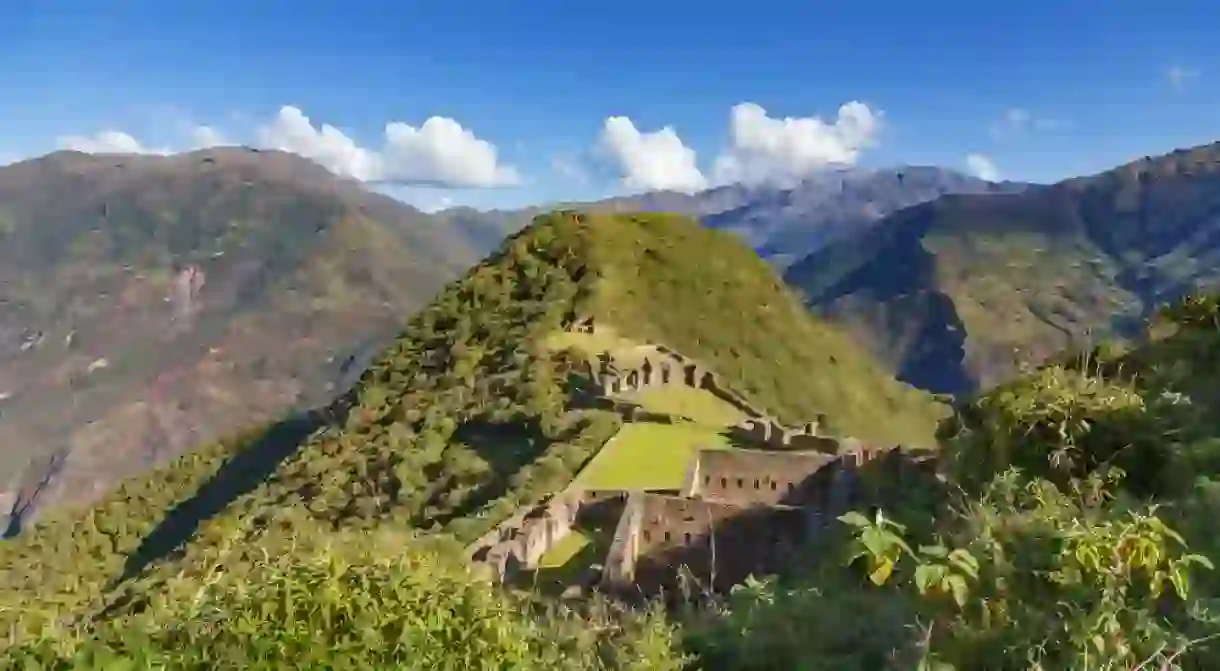Choquequirao: Peru's Secret Alternative to Machu Picchu

Only accessible through a rigorous, two-day hike from Cusco, Choquequirao is the larger, higher, and lesser-known sister site of Machu Picchu. Here’s why it’s worth the extra effort to reach these spectacular Incan ruins, along with everything you need to know about this amazing trek in Peru.
Choquequirao, standing at an altitude of 3,050m (10,000 ft.), is an ancient architectural site that towers above the Apurimac River canyon and rests atop a flattened hill. It was built between the 15th and 16th centuries and most likely served as an administrative checkpoint and place of worship. Centuries after its construction, 12 sectors of the site, featuring a variety of temples, houses and baths still stand today.

After a few daring adventurers discovered the complex, excavations began around 40 years ago. But only about 40% of Choquequirao has been uncovered so far, and much of the site is still a mystery.
Getting there
Trekking to Choquequirao requires venturing deep into the Vilcabamba mountain range and passing through multiple ecological environments and local communities. The route features several passes, many of which are quite high and steep. In addition, the sheer scale of the successive descent and ascent (completed again on the return), coupled with high daytime temperatures (up to 96°F, or 36°C), make for an overall challenging trek that requires great stamina.
The journey starts at the village of Cachora (or alternatively, nearby Huanipaca), at an elevation of about 2,900m (9,500 ft.), and a four-to five-hour drive from Cusco. From there, you’ll descend into the Apurimac Canyon and end your first day at the mountainside settlement of Chikiska. Take some time to rest and look at the stars in the rural night sky. The next day will involve treading along the Apurimac River, through the communities of Santa Rosa and Marapanta.
The real challenge begins when the descent shifts to the main ascent, a steep climb of 3,000m (9,800 ft.) out of the rocky canyon and into the cloud forests. Finally, after at least seven hours of trekking, the trail becomes less intense as the end gets near. After crossing the final bridge, prepare to witness the splendor of Choquequirao.

Exploring the site
The Choquequirao site itself will take another several hours to fully explore, and much of it has been overrun with jungle foliage and wildlife. The complex is surrounded by ancient irrigation systems and terraces, which provided water for residents and agriculture. As a result, much of the site is dedicated to water, as water shrines and buildings near aqueducts are a common sight.
The highest sector contains warehouses, the medium-altitude sector contains the main Ceremonial Plaza, and the lowest sector to the south was set aside for ancestor worship. The Ceremonial Plaza is truly a sight to behold, with a grand staircase leading up to a platform surrounded by water-funneling structures. The other sectors, made up of many terraces, contain a variety of residential units, farming areas, and kallanka ceremonial halls. The skilled stonework at Choquequirao also deserves attention and features inlaid designs of people, llamas and other central figures.

Making the most of the trip
Because the trek doesn’t require a permit like the Inca Trail, it’s possible to trek Choquequirao completely on your own. However, many trekkers choose to join tour groups that offer guides, mules, porters and cooks, making for a safer and more social adventure. Some tours also connect Choquequirao with other sites like Machu Picchu, in longer itineraries.

The trek itself is not typically populated with many other walkers, providing a private experience, and stopping by at villages and interacting with locals offers unique, authentic encounters. Before attempting the journey, it’s a good idea to do some local hiking and exercise, to prepare. Make sure to bring athletic shoes, moleskins for blisters, water, and plenty of sunscreen and bug spray. The mosquitoes might be overwhelming and annoying, but they are not likely to carry any infectious diseases. Campsites are likely to offer overnight equipment.
Choquequirao also lies close to other areas of interest, such as Sayhuite—a mini stone replica of Machu Picchu—and Condor Canyon (which has plenty of, you guessed it, Andean condors). In addition, the region is known for its organic mangoes and avocados; they’re some of the best in the world.

Although Choquequirao is currently remote and out of reach for most, things may change with the plans to build a cable car by 2019. The expensive, government-funded plan will bring investment and new wealth to local communities but will also probably commercialize the area. So, it’s best to make the trip now if you want a more unspoilt experience.













